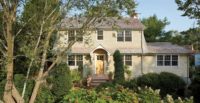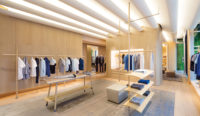Architects may start their careers designing houses, but after they add heftier projects to their portfolios, many are quick to jettison the smaller stuff. This is hardly the case with Odile Decq, who bases her office in Paris and has garnered acclaim for the quietly assertive FRAC Bretagne art museum in Brittany and the daringly muscular GL Events Headquarters in Lyon.
Additional Information:Jump to People/Products
While Decq’s work unequivocally proclaims a fascination for defiantly large steel-and-glass volumes and cantilevers, she recently completed a wood cottage for an artists-in-residence program in southeastern France. As she explains, “I am always interested in something I haven’t done before, such as an artist’s house, which requires providing a workplace along with temporary living quarters.” This is also her first wood structure: “I was thinking of an alpine forest,” she says. “The wood gives the building a quiet tone.”
Intriguingly, the indomitable FRAC Bretagne played a role in Decq’s winning the small, invited competition for this residence and studio on the property of the art collector and patron Colette Tornier, in the community of Seyssins, just outside Grenoble. Tornier knew the FRAC: she and her selection committee (which also decides on the grants to artists) felt Decq’s approach captured the spirit of the place.
The simple cabin is intended to house artists on a rotating basis for three or four months. At the end of the residency, they are given an exhibition (plus catalogue), and one of the works created during the stay becomes part of Tornier’s collection. So far one painter/sculptor, Maude Maris, has completed a stay; Lionel Sabatté, also a painter and sculptor, is currently ensconced in the quirky but inspiring retreat.
Perched on the crest of a hill, the cottage faces out to the historic town of Grenoble and the French Alps. Up the slight slope lies Tornier’s bosque-like park, studded with sculptures from her collection, and the rest of the Tour Saint-Ange estate, which includes a 17th-century farmhouse, expanded into a villa in the 20th century and filled with art. Tornier even converted the barn into a private museum for the collection—which includes artists such as Lilian Bourgeat and Wang Du—and filled an adjoining guest house with its overflow.
In designing the residence, Decq sought to create a monolithic sculpture—one that turns its back on the rest of the compound, looking out to the town in the valley and the jagged mountains beyond. “I hoped the artists would be inspired by the view,” she says. “Also, Colette and her family didn’t need to have a strong intrusion in their views of the outdoors. Nor did I want to compete with the existing architecture.”
By creating a timber over poured-concrete structure, Decq crafted a hulking, hovering object that resembles a very large birdhouse. Its raven hue results from her choice of an asphalt finish for the local pine, which the architect notes is used to waterproof the wood hulls of boats. (She designed a boat in 2006.)
The rooms in the tower are stacked atop each other and canted, to create enclosing walls with oblique lines that perceptually extend the building’s height. These three stories jut up from a horizontal one-story base for the 1,075-square-foot art studio, which is embedded in the hillside. By forging this plinth in concrete, Decq bolstered the existing retaining wall at the rear of the house, where the slope extends up to the sculpture garden.
Because of the slope, the entrance to the house is accessed from a lower sculpture garden on the side. Indoors, you find a mezzanine overlooking the studio, where clerestory windows illuminate this solid backdrop for the work being created.
A coiling steel stair takes you up to a small living/dining area and kitchen, 325 square feet in area, which in turn opens on to a flat deck on the studio’s roof. The stair continues up to the bedroom and bath, also 325 square feet, and then on up to a small study (160 square feet) where a hooded balcony projects out over the landscape. “Here, terminating the axis of the spiral stair,” says Decq, “is this belvedere with a panoramic view above the trees.”
Composite board and natural pine clad the interior surfaces, creating a feeling of a vernacular cabin—yet a cabin containing artful pieces of furniture, such as Yona Friedman chairs, and a small egg-shaped hanging migratory-bird shelter that Decq designed in 2012. The object’s two holes encourage the birds to constantly move in and out, says Decq, and not stay for too long. The artist’s residence functions much the same way. Functional and intimate, it still inspires with its striking presence and a long view out.
PeopleArchitect: Odile Decq
Interior designer: Odile Decq
Engineers: BATISERF (structure) AXESS (fluids)
Consultants Landscape / Urbanism: Jocelyne Icart Structural work: SORAETEC Structure: Bois Conseil Carpentry Mr. Joly Bois Electricity and plumbing: EDMI
General contractor: SEMA
Photographer: Roland Halbe, tel + 49 711 607 4073
Client: Colette Tornier
Size: 1,990 square feet
Construction Cost: $506,000
Completion Date: May 2015 |
ProductsStructural system Wood + Leno floor system Manufacturer of any structural components unique to this project: Carpentry by Mr Joly Bois
Exterior cladding Wood: Silver wood EIFS, ACM, or other: wood burner
Roofing Built-up roofing: wood Elastomeric: waterproof Asphalt
Windows Wooden window frames: CORMO
Interior finishes Walls: Silver wood Floor / Ceiling: Leno floor system
Lighting Interior ambient lighting: Delta light endless 30+
Energy Energy management or building automation system: wood burner
Software Archicad, Rhinoceros
|


















Post a comment to this article
Report Abusive Comment